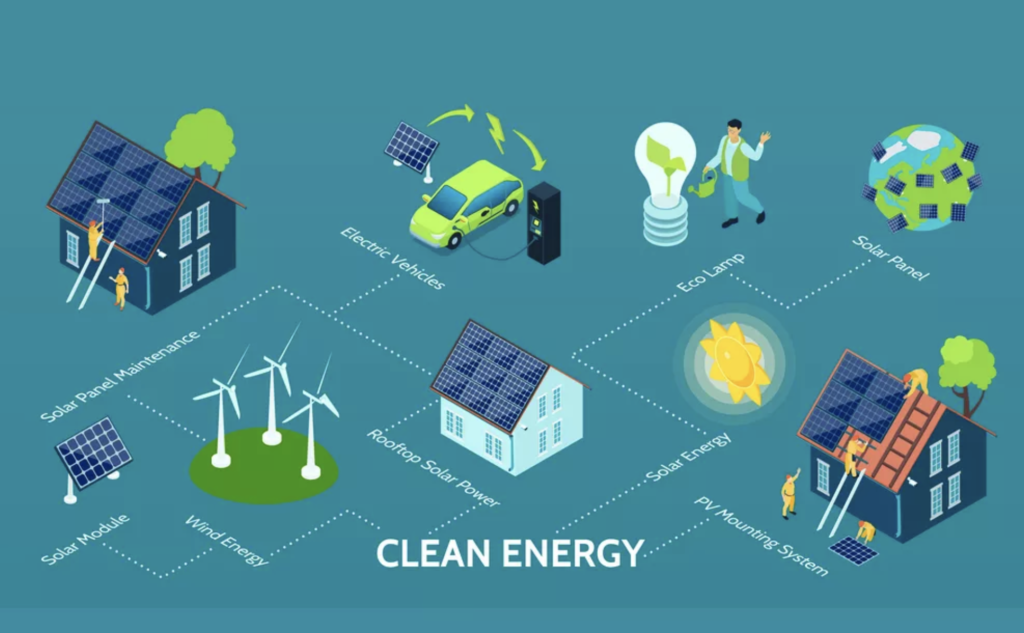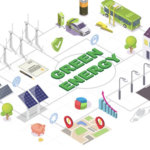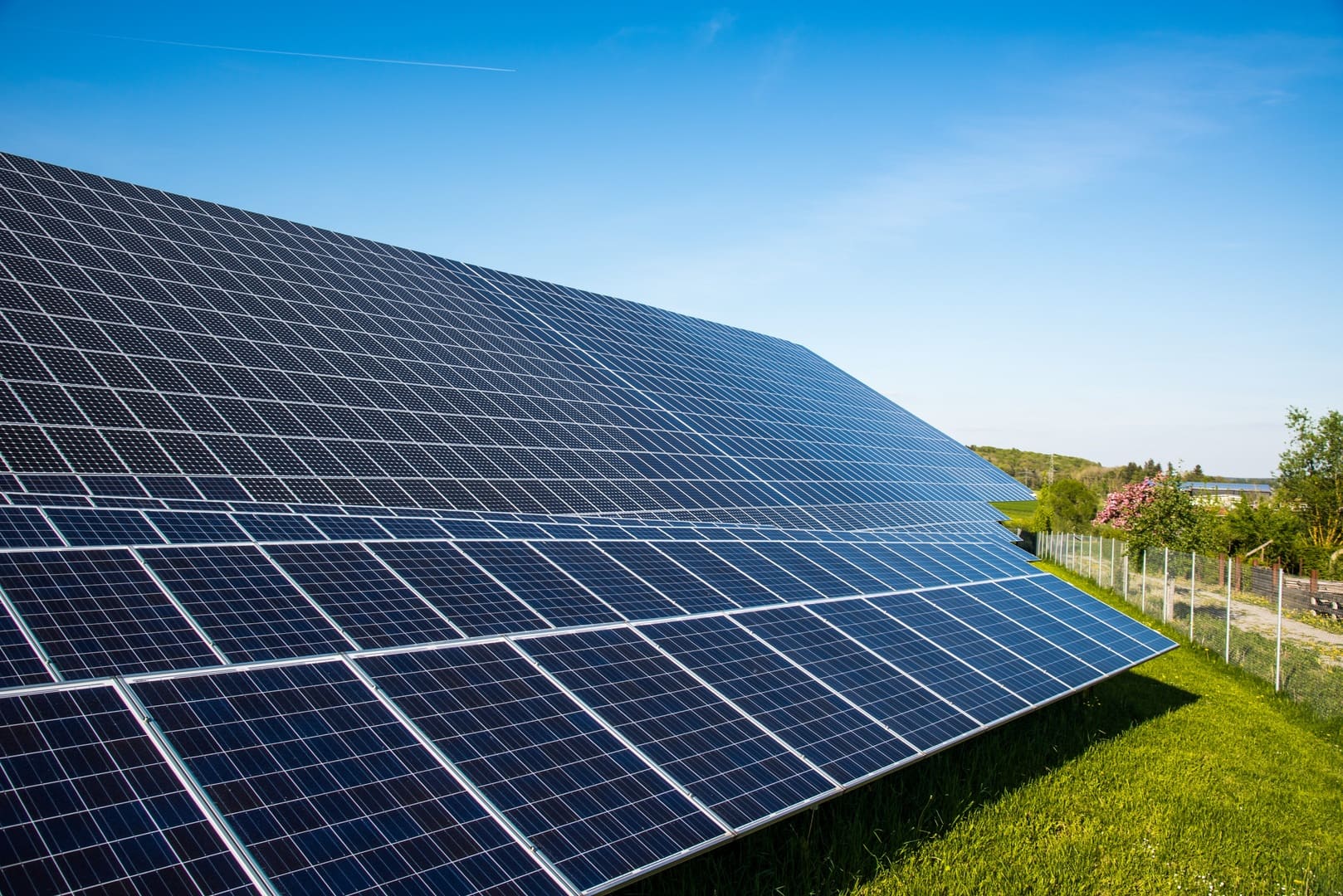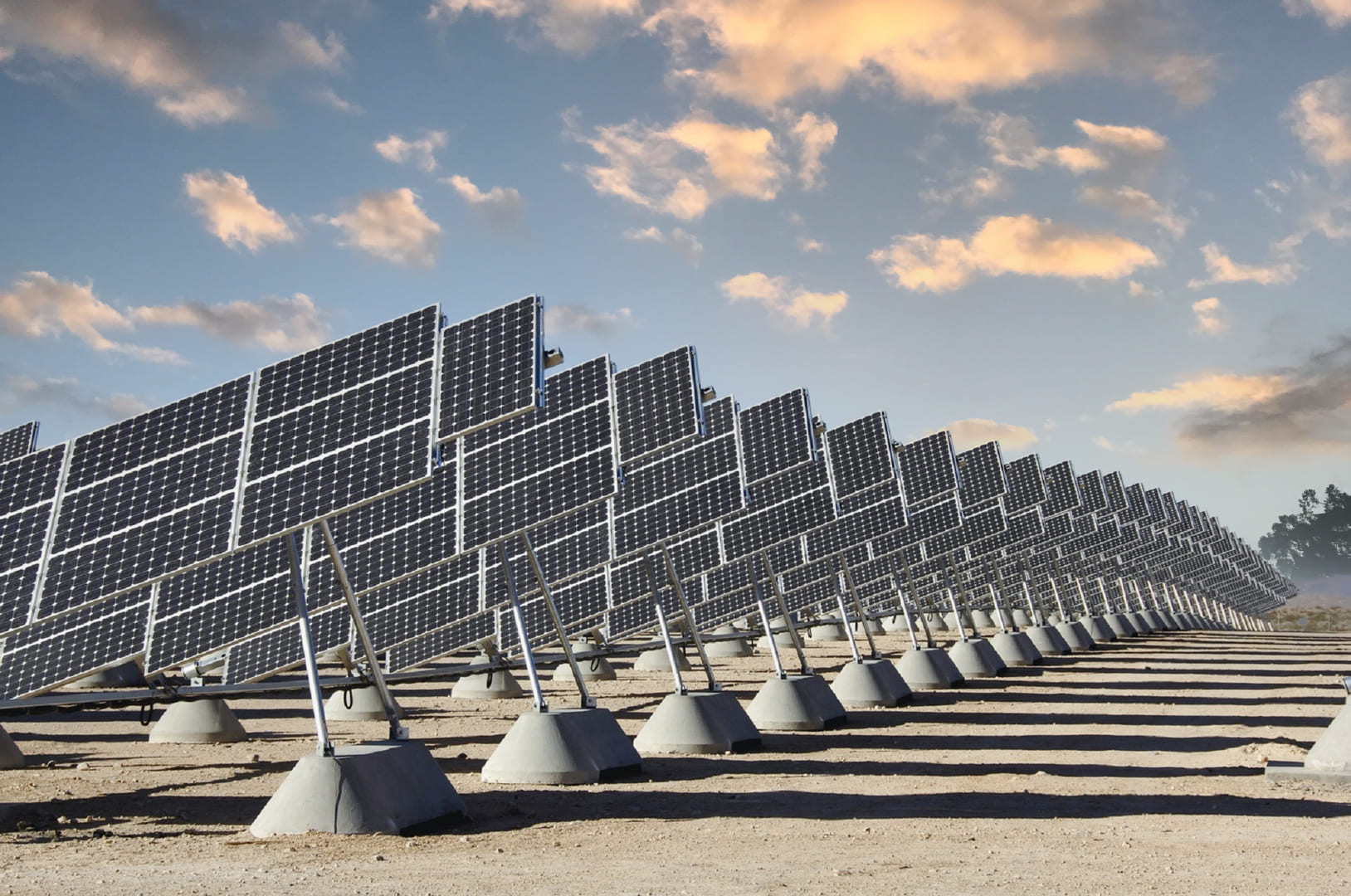Bangladesh’s future in clean energy
Bangladesh aspires to become a developed nation by 2041 and is on track to become a middle-income country by 2025. Prior to the COVID-19 pandemic, it was anticipated that the national demand for electricity would increase due to economic and population growth. Transitioning to clean energy would allow to diversify its energy portfolio towards Renewable Energy in Bangladesh, reduce the risks associated with volatile fossil fuel prices, and reduce the negative environmental impacts of thermal power generation.
Renewable energy (RE) includes energy from the sun (directly), also known as solar, biomass, wind, tidal, geothermal, and hydropower. The endowment of these resources will determine the proportion of each renewable energy source that can be utilized in a country. Bangladesh, for instance, has no geothermal potential, and its hydro potential, particularly that based on elevation, is limited.
Tidal energy in terms of Renewable Energy is a novel energy source that has not yet been commercialized. It leaves only solar, wind, and biomass as viable options. Regarding biomass, the primary issue is the high demand for cooking with agricultural and animal wastes in rural areas. In addition, extracting an excessive amount of organic matter in an unsustainable manner can result in soil degradation. However, there is significant potential through bio-gasification, though it would require careful planning and management of bioresources.
In the case of Future of Renewable Energy in Bangladesh, the primary obstacles associated with biomass are its high price and the difficulty of collecting large quantities, which makes it costly.
Wind has historically been a difficult resource to evaluate in Bangladesh. A group of experts believes that Bangladesh’s wind potential, particularly onshore, is limited. The offshore potential is unknown, despite unsubstantiated claims of its enormous potential. In the absence of comprehensive environmental and technical investment-grade studies on offshore wind potential, it is difficult to comment in financial terms.
Solar energy is the most reliable renewable energy source that can be utilized on a large scale. Local and international investments in grid-connected utility-scale solar parks and industrial rooftop projects confirm this prediction. More than 1,000 MW of utility-scale solar parks and 500 MW of commercial/industrial rooftop solar PV projects under the net metering scheme are on the horizon, according to the chairman of SREDA.

Solar energy is the most reliable renewable energy source that can be utilized on a large scale.
According to the Bangladesh Power Development Board (BPDB), Bangladesh possessed 22,066 MW of grid-connected installed capacity, fuel-wise, as of January 2022. RE accounts for only 2.08 percent of the total installed capacity connected to the grid; half of that, or 1.04 percent, is hydropower, whose generation rate has remained unchanged since 1967. On-grid and off-grid RE applications are included in the full picture of RE deployment.
The majority of the claimed 543 MW of solar power comes from off-grid solar, while grid-connected solar parks contribute only 196 MW. It is important to note that, as a result of the extension of rural electrification and the expansion of the grid, a significant portion of the Solar PV Home Systems that have brought Bangladesh so much notoriety are currently inactive. As anticipated, solar dominates renewable energy in Bangladesh, while other sources are negligible in comparison.
Clearly, Bangladesh is struggling to increase the proportion of renewable energy in its energy mix. The future of renewable energy in Bangladesh is also bleak, unless the government explores new and innovative methods of harnessing RE.
Agriculture land and solar installations
Land scarcity is the single largest obstacle to the widespread deployment of solar PV electricity. Land availability is less of an issue than the policy’s total ban on using agricultural land for solar projects. In Bangladesh, land is extremely fragmented, and it is exceedingly difficult to locate contiguous land on which to build even a 50 MW solar park without encroaching on agricultural land. In lieu of a total ban, a policy could be formulated that permits a certain amount of agricultural land; for example, 25 percent of the land of a single solar park, up to a maximum of 200 acres per project.
One percent of Bangladesh’s total agricultural land can facilitate the construction of approximately 50,000 megawatts of solar power plants. Using the average capacity factor of 4.5 hours per day for Bangladesh, the electricity output from one percent of agricultural land is approximately 82,000 GWh, which exceeds the total demand in 2020.
When the cost of fuel saved is compared to the yield of even three-cropped land, the financial benefits are greater than fivefold. The lost agricultural output of the 1% land can be easily compensated for by preventing spoilage caused by the absence of cold storage and other processing facilities.
Dual use of land and Floating Solar Farms (‘floatovoltaics’) is optimal.
Due to the high cost of land in Bangladesh, dual use of land can make many solar projects financially viable. There are over 2.83 million hectares of low-lying land in Bangladesh (approximately 20% of the country’s total area). Utilizing such low-lying land for fisheries is an example of an innovative solution. The 50 MW solar-fisheries project has been approved, and its implementation has begun.
“Floatovoltaics” are photovoltaic (PV) solar energy systems designed to float on reservoirs, lakes, rivers, and other bodies of water. Floating solar farms can produce vast quantities of electricity without requiring valuable land. Bangladesh, being a riverine nation, is ideal for the deployment of floatovoltaics. Utilizing this potential requires a comprehensive study and pilot projects. Numerous lakes and reservoirs under WASA’s jurisdiction can be developed through private-public partnerships.
Numerous other innovative solar technologies are currently being researched and commercialized. One of the most promising technologies for Bangladesh is “Agrivoltaics”, in which crops are grown beneath solar panels. A conventional solar panel is predominantly opaque to sunlight. Therefore, under the PV panels, few plants will grow.
Therefore, technologies are being developed that can filter this solar bandwidth for electricity production while allowing the infrared and ultraviolet rays required by plants to pass through, i.e. a translucent/transparent solar panel. If this technology achieves full commercial application, Bangladesh’s land shortage will be eliminated.

Network for electricity transmission for Renewable Energy in Bangladesh
Even though Bangladesh is a small country in terms of land area, electricity grid coverage is extremely limited. Invariably, cheap land is situated far from the existing electricity infrastructure.
The government of Bangladesh must undertake a massive grid modernization initiative. The carrying capacity of the national transmission network must be made intelligent and expanded nationwide. Due to the country’s small size, regardless of where the solar plant is located, the grid should be able to deliver power to any location with minimal losses. With a regionally connected, intelligent, integrated transmission network, the intermittent nature of renewable energy can be made more reliable and robust.
Combining solar with a battery energy storage system (BESS)
In many locations, solar PV electricity is already the cheapest source of power, but it is only available when the sun is shining. To make solar PV electricity available at other times and transform it into a true fossil fuel replacement, it must be stored for later use. Currently, batteries are the most promising technology.
BESS is one of several technologies that can increase power system flexibility, reliability, and renewable energy integration to high levels. Lithium-ion chemistries have experienced a price decline of over 70 percent between 2010 and 2016, as a result of technological advancements and increased manufacturing capacity, and it is anticipated that prices will continue to fall.
Technological advances and price decreases
As shown, Fraunhofer Institute for Solar Energy Systems ISE has released the most recent version of its study on the levelized cost of electricity (LCOE) of renewable power plants.
Even though the contained information is applicable to Germany, where wind and solar are very inexpensive and coal is expensive due to a carbon tax, it provides good indications of how renewables, particularly solar PV, are gaining a cost advantage over conventional fuel-based electricity.
In Germany, Combined Cycle Gas Turbine (CCGT), the predominant technology in Bangladesh, is more expensive than PV Utility Scale Battery. The average cost of PV Utility Scale Battery electricity in Bangladesh would be approximately Tk 15, nearly 100 percent higher than in Germany, whereas the average cost of electricity from LNG-based CCGT would be approximately Tk 10.
PV Utility Scale Battery is currently significantly more expensive than one of Bangladesh’s less expensive electricity options, but this 100 percent cost difference is expected to disappear by 2030, making solar electricity comparable in price to conventional electricity.
Consequently, it is crucial to revise the nation’s Power System Master Plan (PSMP) and integrate solar options in a meaningful way, taking into account the rapidly changing reality of utility-scale solar power plants with storage.
On average, the country experiences peak electricity demand for three hours per day, from 7 to 10 p.m. A BESS project may be designed so that during the day, when the sun is shining, the battery pack is charged and then discharged.
It can be demonstrated that this is a financially viable solution; the cost of electricity for PV Battery is significantly lower than for Gas Turbine. Therefore, the peaking Gas Turbine and oil-based (HFO and diesel) power plants can be retired immediately in favor of PV Battery power plants.
Administrative reforms and regulatory modifications

At COP26, Bangladesh announced ambitious renewable energy adoption plans. The Nationally Determined Contribution (NDC) outlines a goal of 4,100 MW of Renewable Energy by 2030.
However, from a private sector perspective, these plans would be difficult to implement absent significant changes to the grid and regulatory reforms. Numerous obstacles posed by the private sector to RE companies impede the widespread adoption of renewable energy. Some of the most significant obstacles are listed below.
The renewable energy (RE) industry in Bangladesh lacks a clear strategic direction in terms of setting goals for specific technologies.
Due to shifting government priorities, certain technologies (Solar Home Systems, Mini-grid) have been impeded.Diverse rival energy sources and power systems are also diverting the government’s attention away from RE.
Small independent power producers’ Fuel Oil-based Quick Rental Power Plants are still a significant and expensive part of the energy mix, and they must be phased out gradually to make room for RE.
Failure of early unsolicited utility-scale solar projects: Land availability and land acquisition, securing the Right-of-Way (ROW), and grid-interconnection issues were the primary points of contention.
Inadequate studies, bankable data, and regulatory checkpoints in the wind energy industry: In terms of acquiring reliable and authenticated data, the private sector faces a high degree of risk. In terms of land availability, substation load capacity, site-specific data, etc., there is a dearth of information.
Foreign investors/lenders are discouraged by project timelines, interagency navigation, contract lock-ins (e.g., a local partner and their foreign partner must be a part of the project for at least six years), and a lack of clarity regarding various regulations.
Modernisation of utility distribution companies The current state of utility distribution companies is insufficient to support widespread RE adoption to serve the local electricity market.
The underlying issues are twofold: first, the level of infrastructure readiness and planning, and second, the capacity and readiness of numerous local level offices.
Renew Energy Bangladesh is the Best-In-Class Products & Renewable Energy Solutions in Bangladesh

Started in 2022, Renew Energy Bangladesh is now a leading renewable energy firm in Bangladesh providing Engineering & Management services in a wide range of Renewable Energy (Engineering Procurement & Construction), Power System and Energy Efficiency sectors.
Our experience encompasses both utility-scale, centralized energy solar farms and nationwide distributed solutions. RENEW ENERGY is capable of developing, constructing, operating, and optimizing photovoltaic (PV)-based solar energy projects. We provide feasibility, detailed design, and project management all the way through construction, financing, asset sale, and ongoing energy production.
We offer a comprehensive and individualized service to organizations planning a solar project of any size. This includes utility/commercial and industrial clients. Our company’s role in these projects may be advisory or project management.
Mini Grid
We have installed solar mini-grids in remote regions that are unlikely to be connected to the grid in the near future. These solar mini-grids are more dependable than our grid power. Due to the absence of load shedding in our minigrids. For instance, in Monpura of Bhola, Daulatpur of Kushtia, Narayanpur of Kurigram, and Sirajganj’s Jamuna river char.
These are remote regions. As there are rivers nearby, it is unlikely that electricity could reach this area. However, it will be extremely costly. Approximately 10,000 households receive electricity from all of these grids. We are the first organization in Bangladesh to provide technical assistance for the widespread deployment of these solar minigrids.
Why would you bother installing a solar energy system on your roof?
Until the FIT (Feed-in tariff) goes into effect, reduce your electricity bill by installing an affordable solar roof solution on your commercial property. By installing a solar power system on your roof, your company can be branded as a GREEN COMPANY that has not only considered reducing greenhouse gas emissions but also saving money on its electricity bill.
Who could install a rooftop solar power system?
When a business has a continuous daytime load, a solar power system without a battery storage facility can be less expensive than conventional grid electricity and generators. Ideal for the roofs of RMG factories, spinning mills, the pharmaceutical industry, the food industry, large storage depots of any kind, ports, courier handling depots at the ports, paper mills, packaging industries, cold storages, etc.
How trustworthy is Renew Energy’s system?
First, allow us to describe the primary components of your rooftop power plant.
- PV Solar Module
- PV Inverter
In our system, Renew Energy only utilizes Tier 1 and Bankable Products. The installation technique has also been mastered by our engineers, who have received extensive training from the company’s experts. We offer a 10-year warranty and after-sales service on the entire system, which is unmatched by any other provider of solar roof top solutions in the country.
In addition, we also mention that these systems have a 20-year lifespan. By participating in the utility scale projects of the IDCOL, we have earned the investors’ confidence. Additionally, we own one of the very first PV power plants of its kind, a Mini Grid that provides clean energy to 10,000 people in Bagha, Rajshahi. We could also install a remote monitoring system that would notify you via your smartphone or email of the plant’s efficiency at each moment of operation.
Construction by IPP
Demand exists for the creation and implementation of a high-quality solar project. Exelon aims to provide uncompromised support throughout the entire process and be a reliable technology and engineering partner. Since our founding, we have worked on a number of prominent Utility Scale solar projects, which you can learn more about in the projects section of our website. We are highly skilled in the following key areas:
- Solar resource evaluation • Site screening and selection • Conceptual design • Shading analysis, yield assessment, and cost study • Grid impact evaluation • Environmental and social impact evaluation • Technical specifications Finalization
- Construction & Installation
ITES and Renew Energy
Renew Energy is dedicated to providing cost-effective solutions for the success of its customers. Software Services and Business Process Optimization are just two of the many services that we provide to assist our clients in operating at peak efficiency. Our expertise is in collecting, organizing, analyzing, and interpreting data in order to provide our clients with meaningful information and a distinct competitive advantage from Design,Development,Testing & Life Cycle management.
Infra-red energy and energy efficiency
Energy Infra and Energy Efficiencies
Reliable Power network infrastructure is essential for addressing the challenges of a dynamic power sector, accommodating the future generation mix, and ensuring a cost-effective and reliable power supply.
Our transmission and distribution team has the knowledge required to assist clients in all aspects of power network planning and operations. We possess the design, engineering, system analysis, economics, and environmental expertise necessary to complete your projects. To save our environment and economy, we promote energy efficiency and the use of renewable energy.
GLOBAL OFFICES:
DHAKA: House 410, ROAD 29, Mohakhali DOHS
DUBAI: Rolex Building, L-12 Sheikh Zayed Road
LONDON: 1156, St Giles Avenue, Dagenham
Email Addresses:
info@trfirm.com
info@tahmidur.com
info@tahmidurrahman.com
24/7 Contact Numbers, Even During Holidays:
+8801708080817
+8801779127165











0 Comments